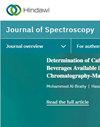Component Prediction of Antai Pills Based on One-Dimensional Convolutional Neural Network and Near-Infrared Spectroscopy
IF 2.1
4区 化学
Q4 BIOCHEMICAL RESEARCH METHODS
引用次数: 1
Abstract
Convolutional neural networks (CNNs) are widely used for image recognition and text analysis and have been suggested for application on one-dimensional data as a way to reduce the need for preprocessing steps. In this study, the performance of one-dimensional convolutional neural network (1DCNN) machine learning algorithm was investigated for regression analysis of Antai pills spectral data. This algorithm was compared with other chemometric methods, including support vector machine regression (SVR) and partial least-square regression (PLSR) methods. The results showed that the 1DCNN model outperformed the PLSR and SVR models with similar data preprocessing for the three analytes (wogonoside, scutellarin, and ferulic acid) in Antai pills. Taking wogonoside as an example, the indices such as the correction coefficient of determination ( R v 2 ), the root mean-squared error of cross validation (RMSECV) for calibration set, the prediction coefficient of determination ( R p 2 ), and the root mean-squared error of prediction (RMSEP) obtained by PLSR modeling were 0.9340, 0.5568, 0.9491, and 0.5088; the indices obtained by SVR modeling were 0.9520, 0.4816, 0.9667, and 0.4117; and the indices obtained by 1DCNN modeling were 0.9683, 0.3397, 0.9845, and 0.2807, respectively. The evaluation metrics of 1DCNN are better than those of PLSR and SVR, and the prediction effect is the best, proving that 1DCNN has a good generalization ability. Especially with outliers of spectra, PLSR’s R p 2 decreased by 0.0181, SVR’s R v 2 decreased by 0.01, and 1DCNN’s R v 2 increased by 0.0009 and R p 2 decreased by 0.0057. The evaluation indices of 1DCNN have no significant change in comparison with no outliers and can still show good performance, which reflects the inclusiveness of the 1DCNN model for outliers. Simultaneously, the feasibility and robustness of the 1DCNN model in the application of near-infrared spectroscopy was verified, which has a certain application value.基于一维卷积神经网络和近红外光谱的安泰丸成分预测
卷积神经网络(cnn)广泛用于图像识别和文本分析,并被建议应用于一维数据,以减少预处理步骤的需要。本研究利用一维卷积神经网络(1DCNN)机器学习算法对安泰丸光谱数据进行回归分析。将该算法与支持向量机回归(SVR)和偏最小二乘回归(PLSR)等化学计量学方法进行了比较。结果表明,1DCNN模型对安泰丸中三种分析物(吴参皂苷、黄芩苷、阿魏酸)的预处理效果优于PLSR和SVR模型。以乌根皂苷为例,PLSR建模得到的校正系数(r2)、交叉验证均方根误差(RMSECV)、预测系数(r2)和预测均方根误差(RMSEP)分别为0.9340、0.5568、0.9491和0.5088;SVR建模得到的指标分别为0.9520、0.4816、0.9667和0.4117;1DCNN建模得到的指标分别为0.9683、0.3397、0.9845和0.2807。1DCNN的评价指标优于PLSR和SVR,预测效果最好,证明1DCNN具有良好的泛化能力。特别是对光谱进行异常值处理后,PLSR的rv2降低了0.0181,SVR的rv2降低了0.01,1DCNN的rv2增加了0.0009,rv2降低了0.0057。与无异常点相比,1DCNN的评价指标没有明显变化,仍能表现出较好的性能,这反映了1DCNN模型对异常点的包容性。同时,验证了1DCNN模型在近红外光谱应用中的可行性和鲁棒性,具有一定的应用价值。
本文章由计算机程序翻译,如有差异,请以英文原文为准。
求助全文
约1分钟内获得全文
求助全文
来源期刊

Journal of Spectroscopy
BIOCHEMICAL RESEARCH METHODS-SPECTROSCOPY
CiteScore
3.00
自引率
0.00%
发文量
37
审稿时长
15 weeks
期刊介绍:
Journal of Spectroscopy (formerly titled Spectroscopy: An International Journal) is a peer-reviewed, open access journal that publishes original research articles as well as review articles in all areas of spectroscopy.
 求助内容:
求助内容: 应助结果提醒方式:
应助结果提醒方式:


